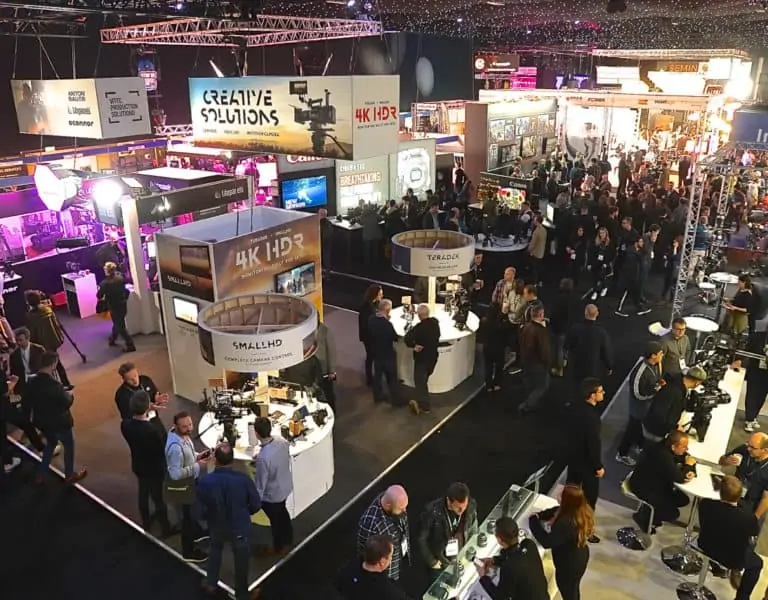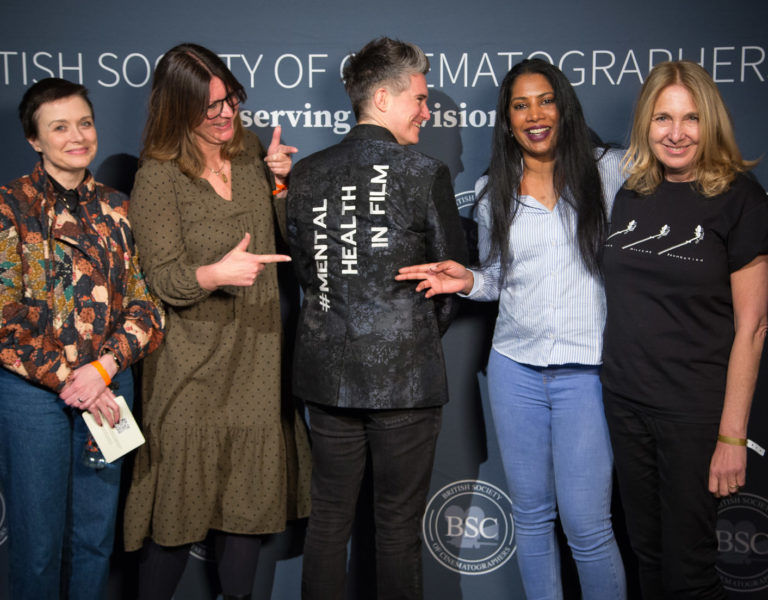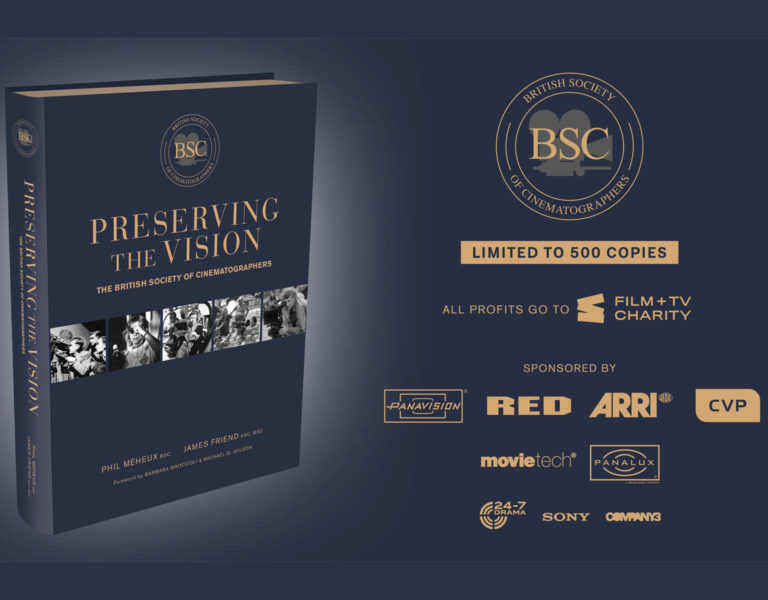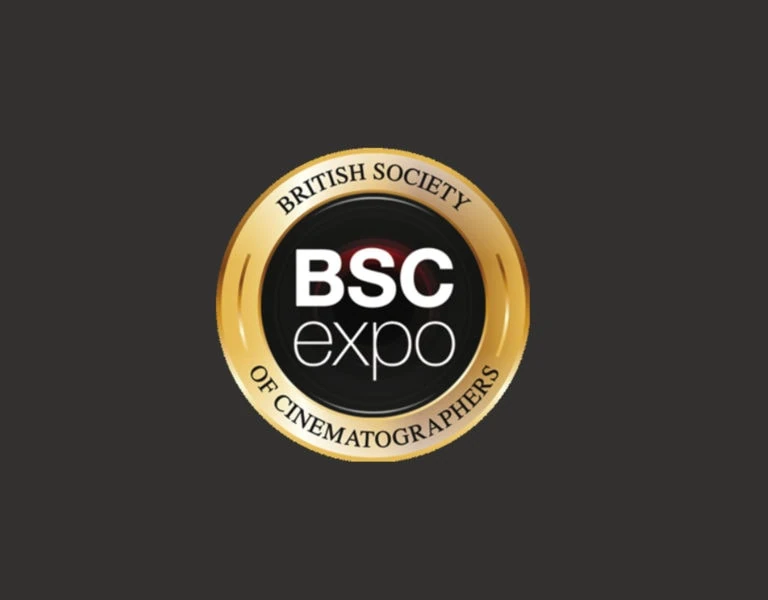BSC EXPO 2022: AT THE CUTTING EDGE OF THE CRAFT
Having been prevented from gathering for two years by the pandemic, it was fantastic to see the industry meet once again at BSC Expo. With 578 exhibitors and 6968 attendees, the event made a triumphant return! The wider aisles were a welcome change, and the visitor count seemed to be very healthy indeed. Conversations on the show floor also highlighted that many people were working in these buoyant times.
Some things had clearly changed in the realm of lighting. There were mainly LED lighting advances and improvements on established technology, along with interesting new examples of engineering and software advances, new lenses, smaller accessories, and many outstanding organisations. A few people also noted the amount of lighting on show, virtually all being LED, with very few, if any, large HMIs on the stands. A packed two days of fascinating seminars and panel debates topped off a very positive and buzzy show.
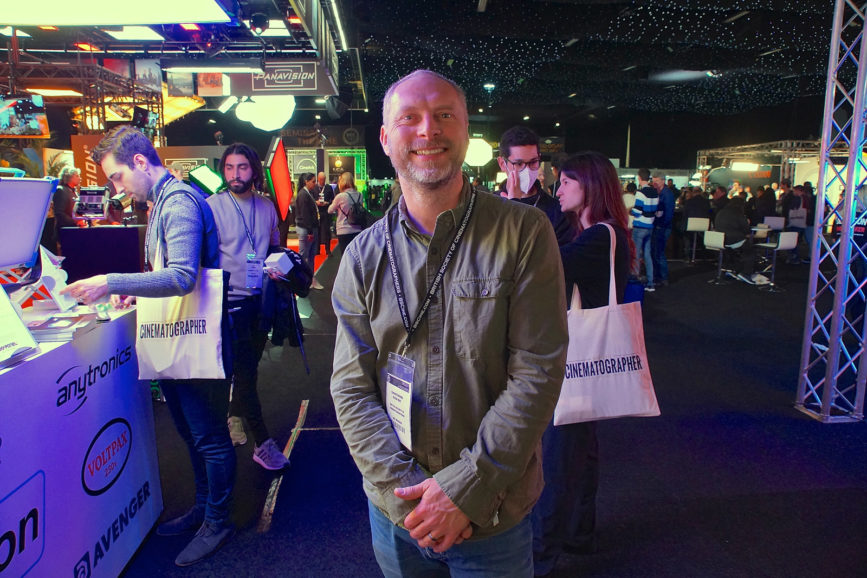
CAMERAS
BSC expo has become a preferred show for launching the latest filmmaking technology. This is particularly true for cameras, with four manufacturers this year introducing new or upgraded models.
RED Digital Cinema‘s V-RAPTOR 8K VV, launched last year, made its exhibition debut but was upstaged by a brand-new product. The V-RAPTOR XL was described as a “big camera” (size-wise) for RED and is aimed at studio and other high-end production work. It has the same image frame rate as the V-RAPTOR, with 8K/120 frames per second (fps) operation.
Panavision showcased the Millennium DXL2 camera. This 8K camera incorporates the RED Monstro large format 35 Megapixels sensor with 16 stops of latitude and 1600 native ISO. The DXL2 is the first camera with built-in electronic and interchangeable flexible modules allowing the customisation of body shape, design, and function, including the change of formats without tools or calibration.
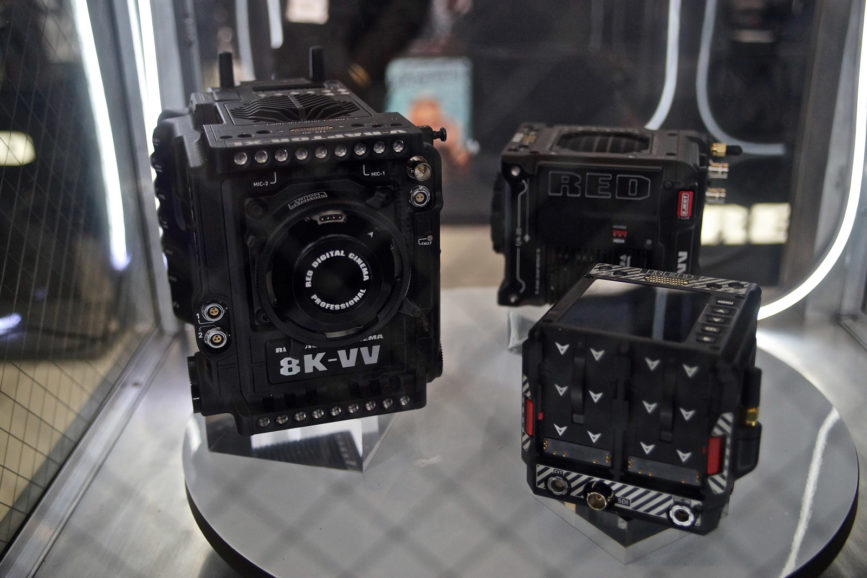
Sony‘s VENICE has been updated to offer what head of connected content acquisition, Claus Pfeifer, described as “sensor modes not in version one”. The 8.6K VENICE 2 also features Cinemascope capability (2.39.1), with shooting in 8.2K up to 72fps and 5.5K up to 120fps. Other ratios offered include Large Format Scope using Full Frame, Super35 17:9/6:9, with support for Super35 full height 2.0x squeeze anamorphic.
Announced at the beginning of the year, the Canon EOS 5 C is the manufacturer’s first full frame 8K Cinema EOS camera. It combines filmmaking capabilities from the Cinema EOS series with the EOS R System’s photographic features. The 5 C has a high-resolution, full frame CMOS sensor, DIGIC X processor and RF mount for 8K shooting.
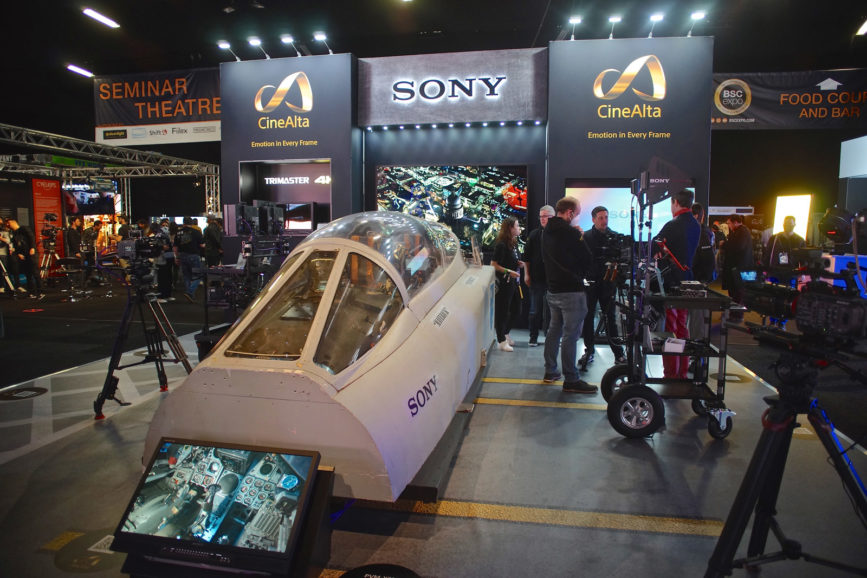
Another early 2022 introduction was Panasonic‘s LUMIX GH6, now the flagship of the Micro Four Thirds G Series. This mirrorless camera can record internally on CFexpress Type B cards at 5.7K using ProRes 422 HQ and ProRes 422 codecs and is aimed primarily at videographers and stills photographers but also for shooting independent films, documentaries and B or C camera footage.
ARRI is well known for quality cameras including the Alexa and is why many award-winning movies such as Dune, Cyrano and The Power of the Dog have been captured using ARRI cameras. Other products being discussed on the Expo stand included lighting innovations such as the Daylight M-series, LED SkyPanels, high quality lenses, the Hi-5 wireless camera and lens control, and the Trinity and Artemis 2 camera stabilisers.
LENSES
Full frame is now a priority for lens manufacturers, as is the case with Leitz‘s ELSIE series, which is due out in the third quarter of this year. It will eventually be a 13 (or possibly more) T2.1 set, ranging from 15mm to 150mm. ELSIE features the LPL (large positive lock) universal mount, introduced by ARRI for digital shooting, which Leitz sees as “the future”.
LPL is a feature of the new re-housed Mamiya 645 lenses for extra-large sensor work from True Lens Services (TLS). TLS has also produced its own range of full frame lenses, Vega, based on Nikon glass. This is a ten-lens cine prime set, comprising 20mm, 24mm, 28mm, 35mm, 50mm, 58mm, 85mm, 105mm, 135mm and 200mm focal lengths ranging from T1.5 to T2. Stephen Lowe, TLS’ lens servicing manager, explained that the company was “generally customer-led” in its output.
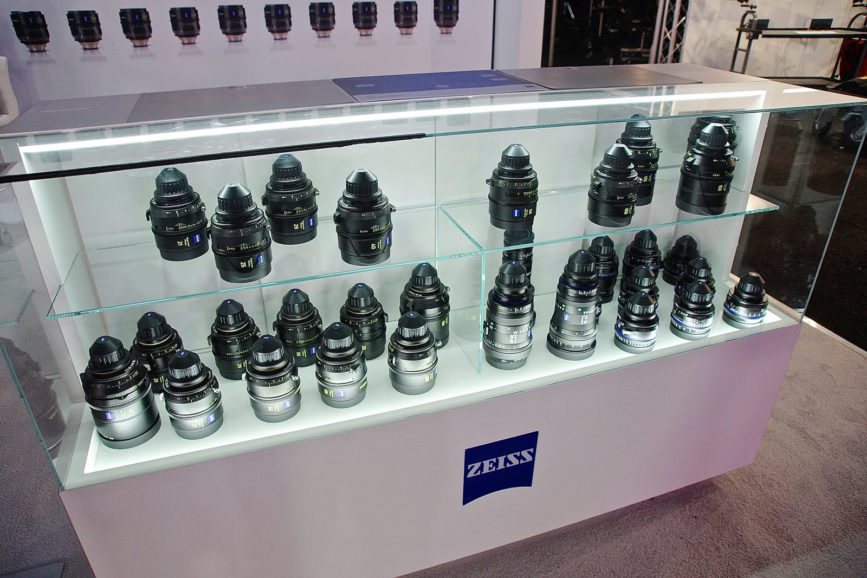
Movietech has a wide set of unique lenses such as the USA made MasterBuilt lenses, offering a vintage character for large format cinematography with optical precision in a distinctive silver body. Also, Gecko-Cam lenses such as the 13 Vintage Ultra Primes ranging between 14mm to 180mm, and the Genesis G35 from 14mm T3.0 to a 135mm T2.0 give a modern vintage look with high-end mechanics.
Movietech also showed the Hawk Anamorphic 2X and 1.3X glass, enabling desirable anamorphic qualities such as barrel distortion, flares, and elliptical bokeh combined with very high resolution. And to complete the line-up was the set of nine Vantage One Spherical lenses between 17.5mm and 120mm, all with the amazing widest aperture of T1.
CINTEK is the exclusive distributor for the Caldwell Chameleon anamorphic 1:79 lenses. Different rear optical groups can be configured for different applications: covering Super 35+ cameras or cover for large format cameras like ARRI LF and the Sony Venice. The Chameleons are all similar sized, and the flare characteristics and aberrations are reminiscent of classic Anamorphic lenses with a unique look.
Over at Zeiss was the new 15mm T1.8 Supreme lens, the 14th addition to the current range of prime lenses between 15mm to 200mm. Consistency is one of the key elements, with lenses mostly having maximum apertures of T1.5 with the 15mm and 150mm at T1.8, and the 200mm at T2.2. The lens diameter fronts are either 114mm or 95mm and size and weight are similar throughout the range.
Fujifilm showed the Premista 19-45mm T2.9, a wide-angle zoom lens with a constant T-stop of 2.9. This new zoom lens complements the range, with the Premista 28-100mm T2.9 and Premista 80-250mmT2.9-3.5. They all share a common front element diameter and three-ring gear positions, allowing users to use the same matte boxes and follow focus.
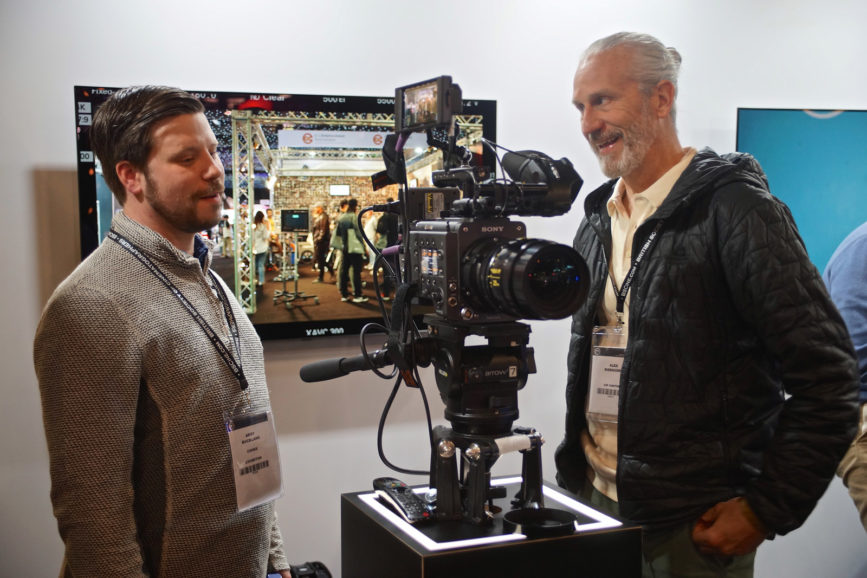
Cooke Optics launched the S8/i Full Frame (FF) series, which is spherical with a T1.4 aperture and at present offers 25mm, 32mm, 40mm, 50mm, 75mm, 100mm, and 135mm. Another nine models are due later this year.
Samyang XEEN, exhibited on the Holdan stand, also had a full frame offering in the T1.3 Meister. This is compatible with PL, Canon EF and Sony E mounts, incorporates /i lens metadata recording and has 13 sheets of aperture blades for natural-looking backgrounds and a round bokeh.
The new Prodigy Air deflector was shown for the first time by Bright Tangerine. Pressurised air is blown over the lens front to keep water away. This unit was recently used successfully on the recent Batman film. They also have follow focus units, matte boxes, camera cages camera accessories, EVF mounts, Titanium 19mm support rods, bridge plates for RED, ARRI, and more.
LIGHTING
LED continued its steady march on to both manufacturers’ product lists and film shoots. New and recent models from NANLUX and NANLITE were on both their own stand and that of distributor Prolight Direct. The latter had made the effort to show only new product, including the NANLUX Evoke 1200, described as a LED version of a HDMI spotlight; the NANLITE Forza 720/720B, promoted as the brand’s brightest spots; and the NANLUX Dyno 1200, regarded as an alternative to the ARRI SkyPanel S360.
The Panalux Sonara fixtures are developed and made in the UK, and the Sonara 4:4 is a 1,500W fixture with a unique chipset used to achieve incredibly accurate white colours with a uniquely wide colour range between 1,600K to 20,000K. Two new family members were unveiled for the first time, including the 500W Sonara 3:2 and a 4:1 version, both inheriting the unique colour features of the Sonara 4:4.
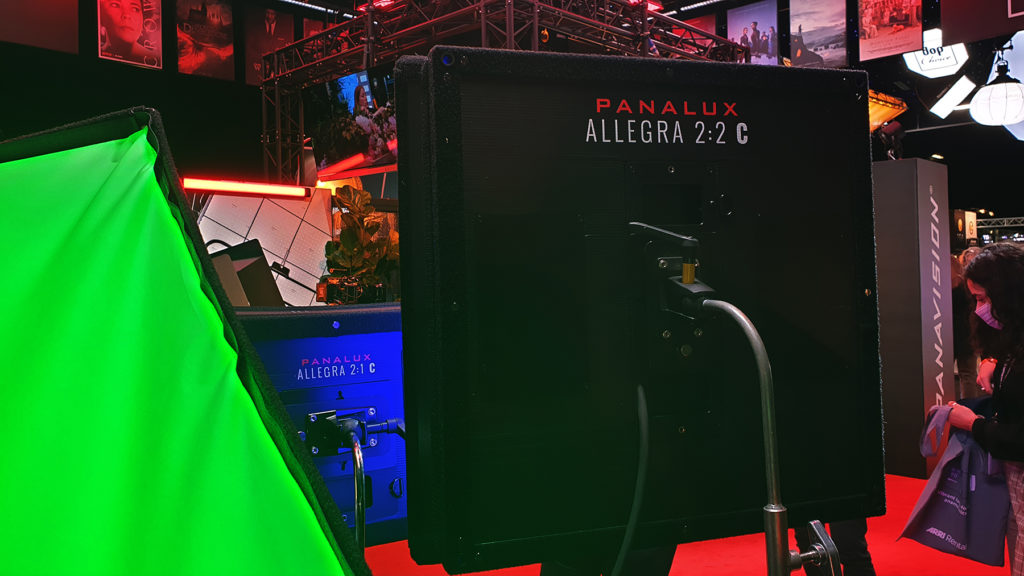
On set sometimes there is no available power, so the new i2 and i4 Panalux Portable Power units deliver electrical power onto location. A portable office with computers and work lights can be set up, or the i4 can run a Sonara 3:2 for 13.5 hours, a LP Gemini 2×1 for 21 hours.
LCA demonstrated the high IP waterproof features of the 2×1 Creamsource Vortex 8 by pumping water over a fully illuminated lamp. Also available is the 1×1 Vortex 4 with the same IP rating features. The LCA stand had the large Auroris, built with 24 large format pixels, creating a pixel mappable source that can cover a 100-square-foot area in accurate white light with just one unit.
Quasar Science demonstrated its Rainbow 2 and Double Rainbow fixtures in virtual studios. Low-res graphics can be generated as an extension of what’s displayed on the videowall behind the subject, creating real-time lighting effects on the subject that instantly matches the background.
Cirro Lite (Europe) showed some classic Kino Flo and Dedo kit and more. The Matthews Air Climber is a lighting stand raised with compressed air from any small compressor, even battery powered. It has a max height of 6.7m (23ft) and can pivot around when extended, with a 90kg payload fully extended.
The new Fiilex Q10 colour 10-inch Fresnel is a 900W LED colour fixture with Dense Matrix LED technology, an 11–70-degree spot/flood range, a 2,000K to 10,000K colour range and IPX5 water resistant rating. This complements the Fiilex Q5 180W Fresnel with a 12–55-degree spot/ flood.
New from Lightstar was the LUXED-P9 full colour spot/space light, described by Prolight Direct‘s technical director, Ossie Jung, as an LED take on the maxi brute. Suspended above was Lightstar’s Airlite range, including the 1000W six-foot balloon ball lamp and the 1000W TUBE eight-foot sausage balloon fixture. Alongside these was the Aladdin Lights MOSAIC 4×4 600W RGBWW panel.
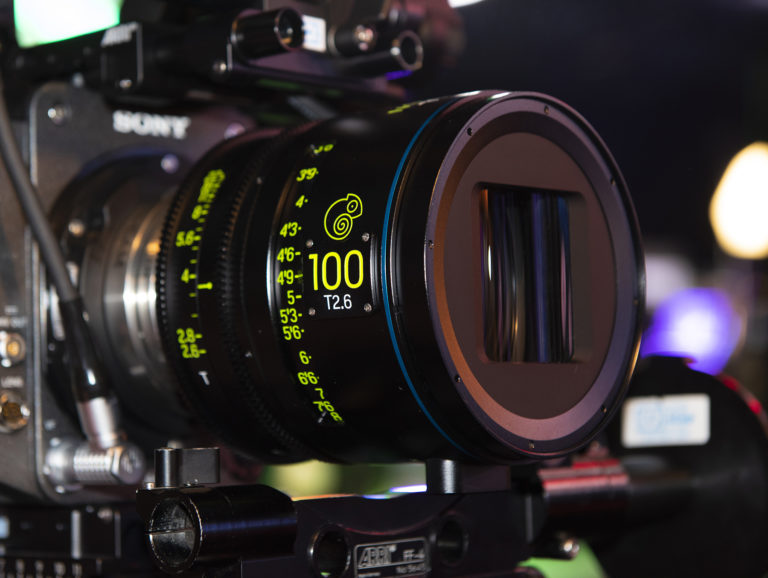
Also on the Prolight Direct stand was The Lightbridge, which was not promoting specific products but, how filmmakers should be thinking about lighting. “We want people to spend more time lighting than setting up the lights,” explained founder, Jakob Ballinger. “What is important is where the light hits.”
The Litepanels Gemini 2×1 and 1x 1 Soft LED panels are now joined by the Gemini 1×1 and 2×1 HARD versions, gives a tighter angle beam, giving a much punchier direct light source.
Chroma-Q’s range of products include LED Battens, Space Lights, House Lights and PARs, with white light, variable white and colour mixing options. The COLOR range of products focus on smooth dimming and wide colour palette, while the STUDIO range focus on perfect whites for camera. The Chroma-Q Brute Force is an LED alternative to the traditional Tungsten quarter ‘Wendy’ light. This full colour RGB-W head draws just 15A @ 240V.
The current shift in LEDs is towards chip on board (COB) technology and away from SMDs (surface mounted devices). Among the manufacturers now applying COB is K 5600, which has added to the Alpha 300 LED Fresnel and Joker 300. The company’s Marc Galerne explained that a 600W COB of about 1cm in diameter was being used to produce a consistent beam without shadows on the Fresnel and which could be dimmed for low light working.
Someone else pushing the boundaries of LED lighting technology is Dr Anqing Lui, the colour scientist behind the Prolycht brand. His aim was to create the most accurate RGB (red, green, blue) ACL (amber, cyan, lime) six-colour emitter currently available. The result was the Orion 300 FS (full spectrum) light source, which was demonstrated at BSC Expo with an Absolute High Speed camera to show it could work with higher speeds.
Rotolight was an early proponent of LED and brought its Titan soft light panels to the fore, while also introducing the new AEOS 2 continuous light with high speed RGBWW strobe and the on-camera NEO 3. The manufacturer’s other products were discussed in a seminar session featuring cinematographer Denson Baker ACS NZCS and gaffer Howard Davidson talking about their work on the film The Colour Room.
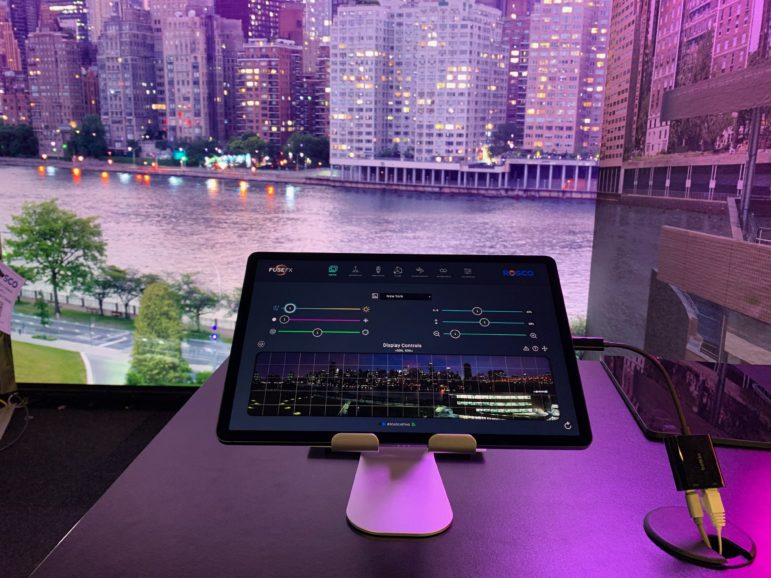
A new high output LED lamp was introduced by SUMOLIGHT. The SUMOMAX, with its hexagonal shape, is a 700W fixture with a high lumen output and modular construction. Designed to be a key, hard, punch, space, or soft light, the SUMOMAX came out of requests by cinematographers, lighting directors, and gaffers for a more powerful entry in the SUMOSPACE+ range.
Cineo Lighting, exhibiting with Universal Production Services UK, recent products included the ReFlex R15 which can perform like Tungsten or HMI sources without the limitations of either. It can be pointed up or down with no issues and delivers over 90,000 lumens on less than 1,500 Watts with a 2700K to 6500K colour range and electronic remote-control spot-to-flood from 15 to 75 degrees. It is liquid cooled using optically transparent dielectric fluid. Also on show was the new Quantum II which features 4th generation LED technology giving an output nearly twice that of the original Quantum with full RGB capabilities and the ability to record and playback a number of lighting effects; and the LB800, which allows for multi-zone operation and can also be run by the C²OS.
DoPchoice creates many high-quality light modifying tools for most top manufacturers and introduced two new Snapbags specially created for single tube Helios and Titan lights from Astera.
Chimera Lighting displayed a mix of standalone fixtures and those designed to work with other manufacturers’ products. These included the new, octagonal Daylite Octa 7, released in February, accessories for the ARRI SkyPanel S30, Medium Lightbank for the Creamsource Vortex 8, and POP Bank for the Aputure P600.
Aputure showed two new tube lights (the two-foot full colour T2c and the four-foot full colour T4c) and four new flexible mats (the high output, full colour F21c and F22c and bi-colour F21x and F22x).
Known for its LED lighting, Rosco Laboratories concentrated on the backdrop side of its business for BSC Expo by showing a prototype interactive background system. RDX (Rosco Digital Experience) LAB was developed with visual effects studio FuseFX to create a digital backdrop especially for virtual production within a LED volume. The system exploits what is described as “the world’s most extensive library of background images”, with Live Action Backdrop technology from FuseFX allowing a chosen image to manipulated on set.
In filters, Tiffen showed warm diffusion filters, Antique Black Pearlescent, Antique, and Antique Satin, whilst the new LEE Elements Variable ND Filter is now available in 82mm screw-in form, allowing 6-9 stops of precise ND adjustment without several different ND’s. Fluid-smooth adjustment rings, positive end stops, and clearly defined stop markers achieves the exact desired amount of density adjustment and prevents cross polarisation.
MONITORS, ON-CAMERA GEAR, AND GRIP EQUIPMENT
As the production chain from acquisition to post-production shortens, some colour grading is now done on set. Not all the monitors being used for this were to post suite standard but now several screen manufacturers, including Atomos and SmallHD, have upgraded units to that level.
Atomos demonstrated the Neon 24 in a practical grading set-up, with updates due in May to make it a reference monitor. Colour and product specialist Victor Aberdeen said part of the reason for the upgrade was because Atomos had redesigned its colour pipeline, with public beta tests due soon.
SmallHD‘s Vision 24 is a 24-inch 4K HDR monitor that was originally shown at IBC 2019, but the hiatus caused by the pandemic, explained Mark Bird, regional sales manager of Creative Solutions (which owns SmallHD, Teradek and Wooden Camera), provided the opportunity to “get it right”. Bird added that the Vision 24 was “the first leap into colour grading reference monitors” for the company. Also on the stand was the newly announced Cine 18 18-inch 4K ‘high-bright’ production monitor. Alongside, Teradek showed the RT lens controller and Bolt 4K Series wireless video system, both of which were displayed fitted to an ARRI camera.
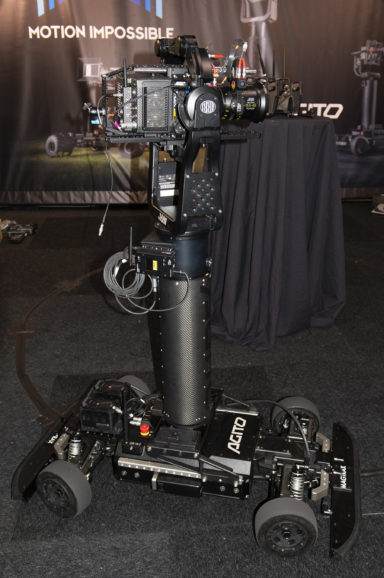
More wireless technology was to be seen on Videosys Broadcast‘s stand. Of most interest to filmmakers was the STX Nano Film Assist System, which is designed to deliver high performance in outdoor areas or where there is congestion on the RF spectrum. The system, which is fan-less and so suited to quiet sets, comprises a transmitter, receiver, and converters.
The traditional Steadicam camera rig was improved many years ago by MK-V with the Alien Revolution, using a controlled roll over camera cage keeping the camera level even when the post is rotated horizontally. This allows much more camera accessibility. New advances: when used with an accelerating vehicle the electronic systems also work out how to keep the camera head level when travelling sideways.
AGITO is a remote dolly system from Motion Impossible. Rob Drewitt demonstrated smooth and fast camera movements up to two metres in height, with accurate and repeatable moves using precise encoded motors that have smooth and accurate control at any speed. It can also follow a magnet strip on the floor or used with radio control. It can achieve the same movements as most of the tracking equipment on the market, rickshaws, jibs, dollies, sliders, and tracking vehicles. British engineering, as seen at the Oscars and Grammys ceremonies, also on Top Gear track shots.
Looking for a camera cart? Inovativ make different camera carts, grip, and utility carts. The Axis 3-wheel system is designed for camera operators, digital technicians, and photographers. The Voyager Evo X workstation has a payload up to 272kg, and the Apollo-with the largest working surface has the highest payload of 544kg.
Sachtler had the rather revolutionary tripod head, the aktiv that releases from a large locking pin inside the legs with a pull on a single lever. This SpeedSwap system enables very fast camera swaps, level the head and locking in place. The tripod legs can lay flat on the floor as there is no bowl clamp.
The trend is now for cages with standard threaded holes to attach and hold devices such as monitors, follow focus units, and more. Ratworks Engineering is a British engineering company making a variety of solid aluminium cages, monitor accessory blocks, port caps, Steadicam post holder, handle grips, and camera plates for Sony Venice, Alexa, and even side plates and top handle for the legendary 16mm ARRI SR3 camera.
OVIDE and QTAKE Pro collaborated to produce an advanced video assist hardware and software combination, with auto record, playback, touchscreen, on set editing, and colour grading on a live signal or playback. QTAKE Pro stores camera metadata such as focus, iris, zoom, white balance, shutter, ISO, and shot notes can be made during or after recording, and applied looks can be added.
Ruben Sluiter was on the MK-V stand showcasing Set Simulator software showing the practicalities and limitations of the location or set before it is built. The set can be “built” and actors added, with camera view shown with a chosen camera/ lens /aperture. Lighting output along with cranes, set design and script timings can be tested and plans made before anyone is on the set.
CINTEK is the distributor for Qinematiq focusing technology. A touchscreen interface brings any object in view can be brought into focus simply by touching it. The focus speeds can be controlled with pinpoint accuracy. The conventional, visible-light image is overlaid on the depth map on to the monitor, phone, or tablet.
Focusbug Technologies’ follow focus system has an ultrasonic base sensor that works as both a rangefinder and receiver for tracking CINE RT BUG Ultrasonic Transmitters. All adjustments can be made remotely without needing to touch the camera. A miniature transmitter can be hidden on actors for fast continuous distance information, with up to four Bug sources tracked to distances of 120′ (36.5m) line of sight.
Curt O. Schaller demonstrated the improvements ARRI has made to the Steadicam. The post length was reduced to make it more manoeuvrable, and had many parts standard from the camera department, such as 19mm bars and control cables. Combined with the Trinity 2 roll over rig for Steadicam, a 360-degree rotation is possible for shots. It now has a wider receiver with a quick plate removeable to put on hand grip control.
Grip Factory’s new GF-Turtle base has been nicknamed the grip’s Swiss army knife. Available as a three- or four-leg version, it can be set up with no tools. There are many 3/8-inch holes and receivers for spigots. It can act as a bazooka base or as a dolly, and a 150mm bowl, a Euro adaptor plate and skateboard wheels can be added for dolly track work. It has a 300kg capacity.
Since the company was formed in 1966, Ronford Baker has manufactured Academy Award-winning tripods and fluid heads that are sold worldwide. Designed and completely manufactured in the UK, Ronford Baker is the epitome of solid British engineering, from fluid heads, tripods, Bazooka base and sliders, track, and video accessories are coming soon.
Traditional hardware came from Panther, with first showings for a brand-new product and the latest version of an existing dolly. The Easy Rider is an electrically powered rickshaw that can also convert into a three-wheel trike. The advantage of being electric, says the company, is that it can reach the desired speed immediately the throttle is opened. The S-Type Series 3 is the newest update of the dolly originally launched at BSC Expo 2020. It now offers a faster moving arm that is electric rather than hydraulic.
SERVICES AND LABS
Kodak‘s stand was testament to the fact that film as a capture medium was not only still in use but gaining ground in many different areas. Julie Taylor-Butt, senior marketing manager for the EMEA and Asia-Pacific regions, commented that as well as 35mm and 65mm being in demand – including for Death on the Nile (65), West Side Story (35), No Time to Die (35/65/65 IMAX) and Don’t Look Up (35) – Super 16 was also enjoying a resurgence. Among productions in this format are Red Rocket, Spencer (with some 35) and the upcoming final series of Doc Martin.
The popularity of celluloid led Cinelab Film and Digital to install an OXScan large format 12K film scanner, which was on its stand but is usually in the lab for 12K 5-perf 65mm and 15-perf IMAX scanning, 8K finishing and 35mm film remastering
Back in the domain of digits, Mission Digital promoted not only its DIT, video playback, and dailies services but also new software development activities. This has produced Origami, a cloud platform that works with a range of tools. The first of these is Phoenix, designed to deliver VFX pulls anywhere at any time.
The Tiffen Steadicam workshops are designed to get beginners operating. Bronze is a 2-day course using smaller rigs up to and including the Zephyr. Silver is a 3-day workshop showing all basic techniques, blocking out shots, compositional aspects, and timing with bigger rigs. Gold is a 5.5-day total immersion experience from raw beginners to experienced operators wishing to improve, with more complex shots including vehicles and other moving platforms.
CVP was back on the mezzanine floor with its lens bar, monitor wall, and displays of cameras and hardware, plus new areas for virtual production and NDI workflow. CVP says it has seen a rise in virtual production over the last two years and is now working with disguise, Ncam, TrackMen, ARRI, and ROE Visual, which handles GhostFrame green screen and tracking technology. The NDI display featured a NewTek Tricaster mini 4K system with BirdDog, Canon, and Panasonic PTZ cameras, creating an IP workflow connected by the Network Device Interface.
ORGANISATIONS
The Guild of British Camera Technicians was established for qualified, and craft trained camera technicians dedicated to upholding quality and standards in the film, television, and related media industries. The GBCT runs very successful trainee schemes; the selection process takes place between July to October 2022, with placements starting in January 2023.
The Mark Milsome Foundation is inspired by the achievements, character, and unique nature of Mark Milsome who was killed whilst filming a car stunt in Ghana on 18 November 2017. The Mark Milsome Foundation Film & TV Online Safety Passport Course is now available. The course takes 90 minutes and costs £20 plus VAT. It touches on all areas that the foundation believes failed Mark Milsome in 2017 (www.markmilsomefoundation.com).
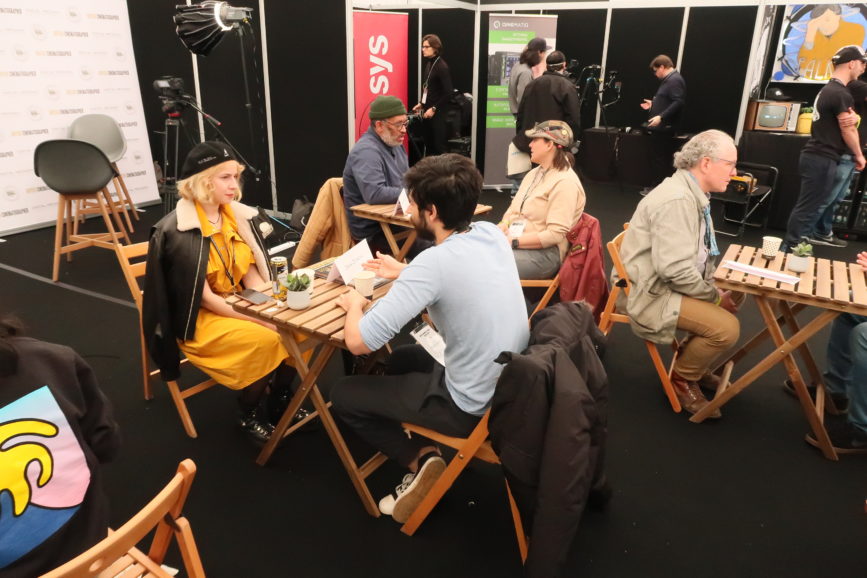
Digital Orchard Foundation and partners brought back the Talent Bar in 2022 – a welcoming space for new and established filmmakers created to help talent move forward in camera and post-production, offering on-site resources, networking opportunities and expert advice and guidance sessions. It’s a place for anyone who is new to the industry or is an experienced professional seeking support to progress. This year, partners include 104 Films, 6ft From the Spotlight, BEAM Network, BECTU, BFI LGBTQI+, Creative Access, Film & TV Charity, illuminatrix, Post Super, Primetime, The British Blacklist, and Women Behind The Camera, BSC D&I Committee, as well as media partners British Cinematographer and Cinegirl. You can watch interviews with mentors, mentees, and a variety of filmmakers and industry associations which were filmed at The Talent Bar on our BCinePlayer video-on-demand platform.
The ACO (Association of Camera Operators) – a voluntary organisation, made up from professional feature film, commercials, and television drama camera operators – continued to inclusively celebrate and promote the technical and creative skills of the camera operator at the Expo. The association recognises the need to embrace new skills and ways of working, and to give a solid grounding in the creative and technical traditions of the craft. At the show, the team discussed the seminars, training workshops, and articles they produce which demonstrate how the skills of the camera operator are central to the artistic and economic success of any production.
The BSC stand is always a focal point to make a beeline towards due to the huge combined talent of BSC members who mingle and meet there. Highlights this year included Harvey Harrison BSC signing copies of his book Check the Gate. Copies of the book Preserving the Vision – edited and compiled by Phil Méheux BSC and James Friend ASC BSC and celebrating the history of the BSC – were also available.
With 2022 marking the 30th anniversary of EnergaCAMERAIMAGE Film Festival, this was one focus and topic of discussion at the festival’s Expo stand. Following last year’s event, which in the middle of the pandemic, managed to present 231 films to 470 cinematographers from 50 countries, more than 300 students and 100 press delegates, along with 655 special guests including directors, screenwriters, and producers from around the world – the festival will be held between 12-19 November 2022, once again in Toruń, Poland. Dedicated to the art of cinematography, Camerimage has established itself as an alternative to traditional film festivals, and a great forum for presentation and development of international filmmaking through masterclasses and seminars.
Alongside the innovation and creativity on display on the show floor, attendees enjoyed a spectacular line-up of panels, seminars, and presentations in the seminar theatre. You can watch a selection of these sessions by heading to our BCinePlayer video-on-demand platform (https://bcineplayer.com/).
